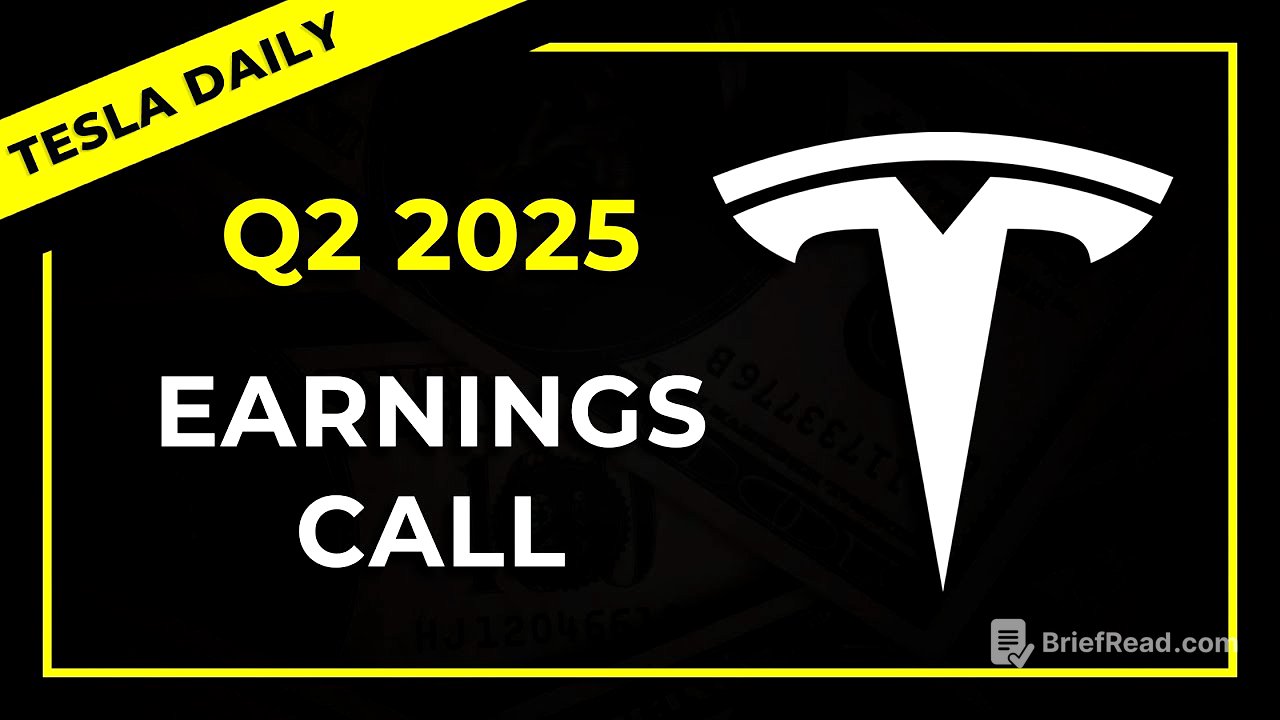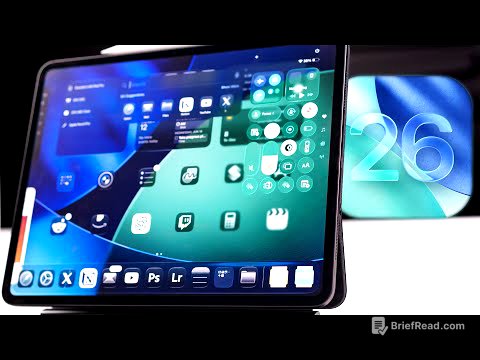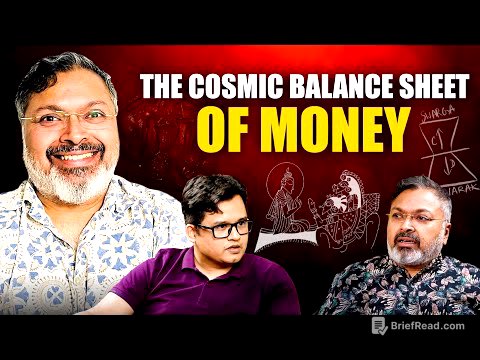TLDR;
This Tesla Daily video summarizes Tesla's Q2 2025 earnings call, highlighting key announcements and insights from Elon Musk and other executives. The main focus is on Tesla's progress in autonomy, including the launch and expansion of the RoboTaxi service, advancements in FSD, and the development of Optimus. The call also addresses financial aspects, such as the impact of tariffs and the IRA EV credit changes, as well as updates on energy storage and production plans.
- RoboTaxi service expansion and regulatory approvals
- Advancements in FSD and AI hardware
- Optimus development and production timeline
- Financial impacts of tariffs and IRA changes
- Energy storage growth and future prospects
Introduction [0:00]
The head of investor relations introduces the Q2 earnings call, mentioning the presence of Elon Musk, Bean, and other executives. The discussion will cover the business outlook and forward-looking statements, with a reminder that actual results may differ due to various risks and uncertainties detailed in SEC filings. The call includes a Q&A session where participants are limited to one question and one follow-up.
CEO Elon Musk opening comments [0:46]
Elon Musk discusses the successful launch of the RoboTaxi service in Austin, noting its expansion and plans for further growth. Regulatory approvals are being pursued in the Bay Area, Nevada, Arizona, and Florida, with a goal to cover half the US population by year-end, pending approvals. Model Y became the best-selling car in several European countries and possibly worldwide, with supervised self-driving as a significant selling point, despite regulatory challenges in Europe and China regarding supervised FSD approval. Tesla is working with regulators in the Netherlands and hopes to soon provide the same FSD experience as in the US.
Within the US, Tesla plans to relax the driver monitoring system as confidence in safety grows. The production release of autopilot is behind the RoboTaxi version in Austin, but improvements are coming to autopilot for users outside Austin. Autonomy is key to amplifying Tesla's value, requiring both physical products and advanced AI. The Tesla diner launch has been a success, drawing worldwide attention.
Significant software improvements are being made to full self-driving (FSD), with plans to increase the parameter count by almost 10x. Energy is growing well despite tariffs and supply chain issues, with mega pack capacity expanding and record power deployments in Q2. Battery demand is expected to be massive, with batteries potentially doubling the US energy output.
Optimus development is progressing, with Optimus 3 featuring an exquisite design. Musk predicts Optimus will be Tesla's biggest product ever, requiring custom design of every component. Tesla is applying AI techniques from cars to Optimus, leveraging its expertise in real-world AI and inference efficiency. Tesla has the highest intelligence density in AI, which will be crucial in the future. Prototypes of Optimus 3 are expected by the end of the year, with scaled production next year, aiming for a million units annually within five years.
In conclusion, 2025 has been exciting with major milestones and demonstrable progress in autonomy. Musk believes Tesla can become the most valuable company in the world with continued execution in vehicle and humanoid robot autonomy.
CFO Vaibhav Taneja opening comments [16:15]
Vaibhav Taneja discusses Q2 highlights, including the ramp-up of Model Y production and the launch of the RoboTaxi service in Austin. The repeal of the IRA EV credit of $7,500 by the end of the quarter poses near-term challenges, limiting vehicle supply in the US. Changes to emission standards will impact regulatory credit sales, affecting revenues. The entire automotive product lineup is updated globally, with increased test drives. Production of lower-cost models started in H1 2025, but the ramp-up will be slower than expected due to the focus on maximizing US production before the EV credit expires.
All Tesla vehicles are capable of autonomy, setting a new safety standard with FSD, which is 10x safer than cars without it. FSD adoption is increasing in North America, especially since version 12. Automotive revenue increased by 19% sequentially, driven by improved ASPs from the new Model Y, improving margins despite tariff costs. Tariffs increased costs by around $300 million, impacting automotive and energy sectors, with full impacts expected in future quarters.
Energy generation and storage margins improved, with record gross profit despite reduced deployments due to power ramp-up. Industrial storage is crucial for AI and data center growth, with customers accepting tariff impacts. The big bill has adverse impacts on the residential storage business due to early expiration of consumer credits. Service and other business margins improved due to higher supercharging profits and improved insurance and service center profitability.
Operating expenses grew due to investments in AI projects, including employee-related costs and depreciation for AI compute. R&D spending will continue to grow for long-term positioning. Other income grew due to mark-to-market adjustments on Bitcoin holdings. While operating cash flows increased, so did capex, resulting in $146 million of free cash flow, with investments in manufacturing and AI initiatives. The capex expectation for the year is in excess of $9 billion.
In summary, near-term challenges exist due to the bill and tariffs, but investments in AI, robotics, and energy position Tesla for a bright future.
Investor questions [24:00]
Tesla is asked about the performance and expansion plans for RoboTaxis. The service is performing well in Austin, with positive customer feedback. Expansion in Austin is planned to more than 10x the current operating region. Testing is underway in other cities, with the San Francisco Bay Area as the next expansion target, initially with a driver in the seat pending regulatory approval.
Regarding unsupervised FSD, Tesla is asked about remaining hurdles and timelines. Supervised personal use is expected by the end of the year in certain geographies, with extreme caution being exercised. The AI hardware in Austin RoboTaxis is the same as in some customer vehicles, and cars are delivered autonomously from the factory. By the end of the year, cars in the Bay Area will be delivered autonomously from the factory by default.
Tesla is asked about Optimus' factory tasks and production timeline. The Optimus 3 design is considered the right design, with prototypes expected in three months and production starting early next year. Production ramp-up is difficult to predict due to supply chain and internal process challenges. Tesla aims to produce 100,000 Optimus robots a month within five years.
Regarding more affordable models, production started in June, with a ramp-up around the quarter. The focus is on maximizing production of current models in North America due to the IRA cliff ending in Q3. The new, more affordable models will be available in Q4, aiming to maintain revenue and gross margin while offering a more affordable car.
When asked about the benefits of Tesla investing in XAI, Tesla declines to discuss the topic in this forum. Shareholders are welcome to put forward proposals.
Regarding the Tesla design studio, details are not disclosed on earnings calls, but exciting developments are underway to ensure an exciting future for Tesla's product lineup. A fundamental transformation is occurring from a pre-autonomy to a post-autonomy world, with a new master plan in development.
When asked about news for hardware 3 users getting retrofits or upgrades, the focus is first on getting unsupervised FSD done on hardware 4. After that, Tesla will assess what needs to be done with hardware 3 cars.
Regarding Dojo and whether XAI could be a customer, Dojo 2 is expected to operate at scale next year, with around 100k H100 equivalent. The AI5 chip is expected in volume production around the end of next year. Tesla is considering convergence between Dojo 3 and the AI6 inference chip.
Regarding the BBB elimination of tax credits for solar projects, Tesla's sales pipeline is diversified across customers and market segments. Storage is being recognized for unlocking grid efficiency. Solar projects will still be built due to energy needs and a lack of alternatives. Growth is expected in the data center segment and standalone storage projects. A strong second half of the year is forecasted as deployments increase. Tesla continues to invest in US manufacturing to mitigate policy and tariff impacts, with the first LFP cell manufacturing facility expected online by the end of the year and a third mega factory near Houston in 2026.
Analyst questions [36:15]
Analysts inquire about RoboTaxi KPIs, such as the number of vehicles, miles driven autonomously, and safety-critical interventions. Tesla reports over 7,000 miles operating in Austin with a handful of vehicles, expanding both the area and the number of vehicles. There have been no notable safety-critical incidents, with restrictions like speed limits set for convenience rather than safety.
Regarding the cost per mile for RoboTaxis, Tesla aims for sub-30 cents per mile with the CyberCab, optimized for autonomy. The CyberCab design prioritizes cost efficiency over cornering and acceleration, using more efficient tires and gentle ride characteristics. Optimus could further reduce costs by handling cleaning and maintenance. The cost per mile for the existing fleet will be higher but still competitive, around 50 cents. The RoboTaxi fleet is expected to grow from tiny to gigantic, materially impacting financials around the end of next year.
Analysts question Elon about his comfort level with a 13% stake in Tesla, given the move into physical AI and autonomous humanoids. Elon expresses concern and hopes it will be addressed at the upcoming shareholders meeting. He wants enough control to ensure Tesla goes in a good direction but not so much that he can't be removed if he goes crazy.
Regarding Optimus, analysts ask when others will get a firsthand view and whether an AI day is planned. Elon mentions that competitors closely copy Tesla's AI day presentations. The annual shareholder meeting may include in-depth discussion of Optimus and AI. Tesla is underrated in AI chip design and software, with the AI5 chip being a profound game changer, potentially needing to be nerfed for markets outside the US due to export restrictions. There will be Optimus robots on stage at the shareholder meeting.
Analysts ask about putting non-Tesla-owned vehicles into the RoboTaxi network. Tesla is focused on ensuring it works with fully controlled vehicles first, with a cautious approach to safety. Confidently, next year, people will be able to add or subtract their car to the Tesla fleet, with a checklist process similar to Uber or Airbnb.
Regarding the costs associated with scaling the RoboTaxi business, Tesla plans to debt finance it once there is a clear cash flow stream. In the interim, the balance sheet will be used, with potential for a transaction to get funding once a certain scale is reached.
Analysts inquire about FSD subscription trends and take rates. Since launching version 12 of FSD in North America, there has been a marked improvement in FSD adoption, with a 25% increase since bringing down the pricing and making the subscription more affordable. A car on FSD is 10x safer, and at $99 a month, it's like getting a personal chauffeur for $3.33 a day. Most people still don't know it exists, and half of Tesla owners who could use it haven't tried it. Tesla plans to educate them through service visits and videos.
Regarding pricing as a tool to drive auto vehicle growth, Tesla is in a weird transition period with the loss of incentives in the US but still has incentives in other parts of the world. Autonomy is most advanced in the US. There could be a few rough quarters, but once autonomy is at scale in the second half of next year, Tesla's economics should be very compelling.
Analysts ask for more detail about the lower-cost model. The biggest obstacle remains that people don't have enough money to buy the car. The more affordable the car, the better. It will be a big deal when people can release their car to the fleet and have it earn money for them, which is expected to happen next year in the US.
Analysts inquire about managing the division of efforts and recruiting between XAI and Tesla. XAI is doing terabyte-scale models, while Tesla's are 100 times smaller. XAI was created because some AI engineers wanted to work on ASI and wouldn't join Tesla.
Rob's review and questions [59:23]
The host reviews the Tesla earnings call, noting the stock's slight decline despite exciting announcements. He believes the market may be nervous about management's acknowledgement of potentially rough quarters ahead due to the EV credit going away. However, he emphasizes the importance of Tesla's investments and future potential, which are what shareholders are owning the shares for.
He highlights the expected increase in the RoboTaxi service area, potentially 10 times the current size, and the fact that improvements driving RoboTaxi performance are not yet in the production software. The 10x parameter count increase is also significant. He notes that Tesla is feeling very positive about these developments.
The host expresses hope that Tesla will figure out FSD in Europe and improve driver monitoring. He reiterates the bullish commentary on energy and the discussion on Optimus. He emphasizes that Tesla is the leader in intelligence density, which is crucial for real-world AI.
Overall, the host describes the call as "excitingly unexciting," with no major negative surprises and thesis-reinforcing positives. He believes Tesla is executing on its autonomous robotics future and giving reasons to be optimistic. He concludes that the biggest thing to watch is the RoboTaxi rollout and expects dramatic progress by the next earnings call.









